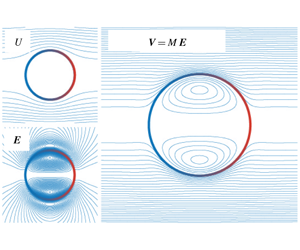Published online by Cambridge University Press: 18 May 2020

A theoretical analysis of the dynamic electrophoretic mobility of surfactant-stabilized nano-drops is undertaken. Whereas the theory for rigid spherical nanoparticles is well developed, its application to nano-drops is questionable due to fluid mobility of the interface and of the surfactant molecules adsorbed there. At zero frequency, small drops with surface impurities are well known to behave as rigid spheres due to concentration-gradient-induced Marangoni stresses. However, at the megahertz frequencies of electroacoustic (and other spectral-based) diagnostics, the interfacial concentration gradients are dynamic, coupling electromigration, advection and diffusion fluxes. This study addresses a parameter space that is relevant to anionic-surfactant-stabilized oil–water emulsions, using sodium-dodecylsulfate-stabilized hexadecane as a specific example. The drop size is several hundred nanometres, much larger than the diffuse-layer thickness, thus motivating thin-double-layer approximations. The theory demonstrates that fluid mobility and fluctuating Marangoni stresses can have a profound influence on the magnitude and phase of the dynamic mobility. We show that the drop interface transits from a rigid/immobile one at low frequency to a fluid one at high frequency. The model unifies electrokinetics and equilibrium interfacial thermodynamics. Therefore, with knowledge of how the interfacial tension varies with electrolyte composition (oil, surfactant and added salt concentrations), the particle radius might be adopted as the primary fitting parameter (rather than the customary  $\unicode[STIX]{x1D701}$-potential) from an experimental measure of the dynamic mobility. This theory is general enough that it might be applied to aerosols and bubbly dispersions (at sufficiently high frequencies).
$\unicode[STIX]{x1D701}$-potential) from an experimental measure of the dynamic mobility. This theory is general enough that it might be applied to aerosols and bubbly dispersions (at sufficiently high frequencies).